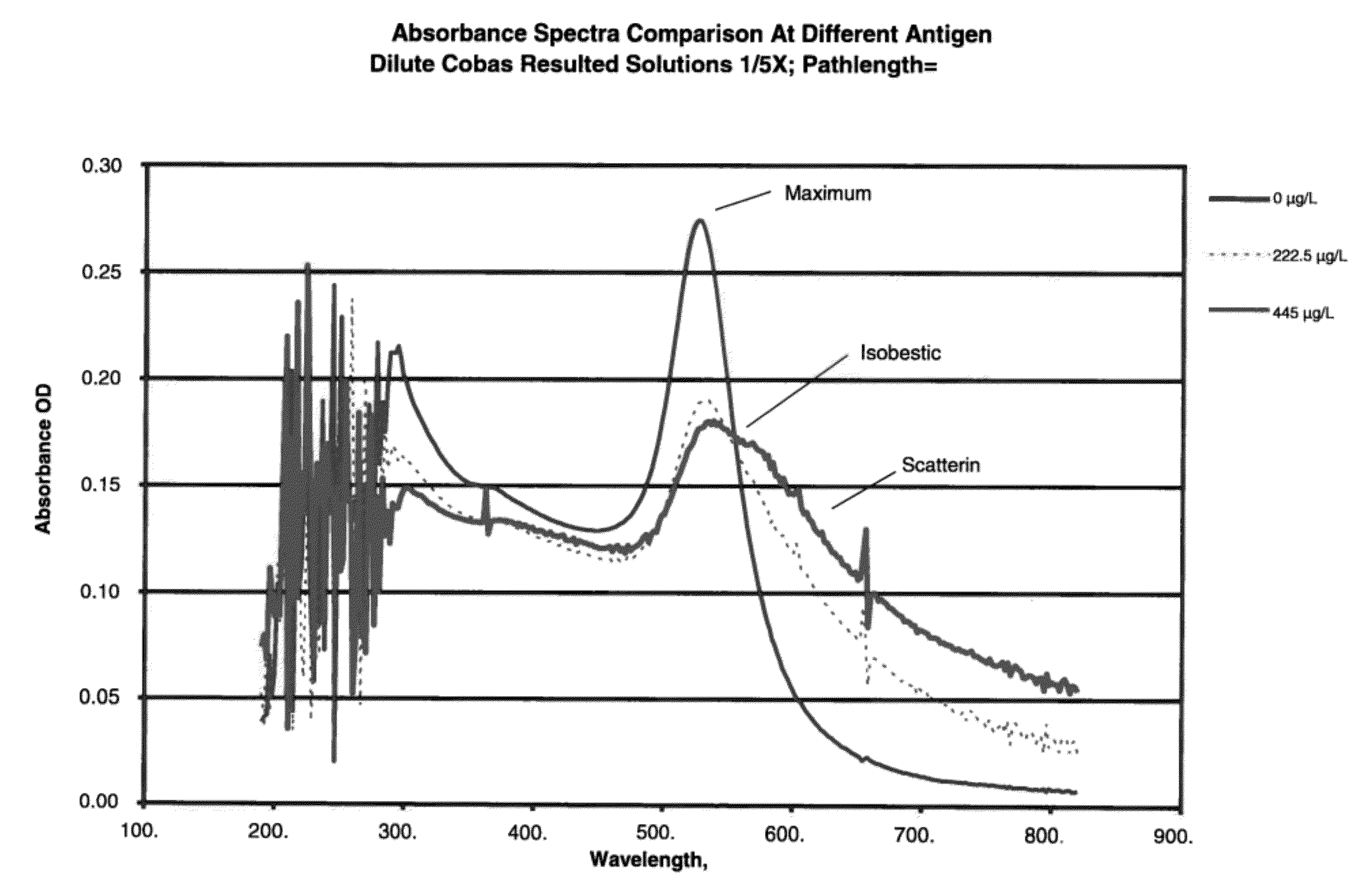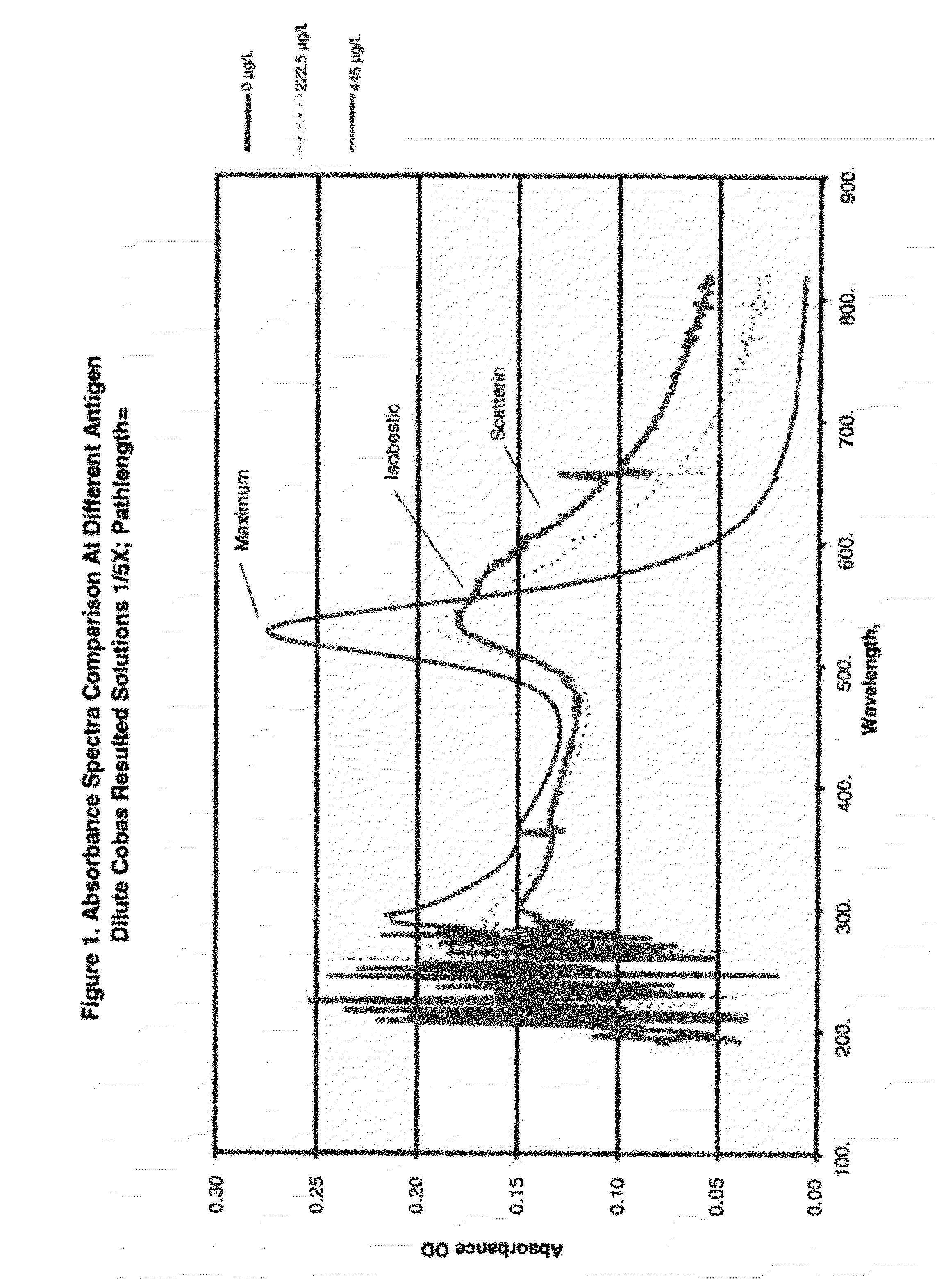Multi-wavelength analyses of sol-particle specific binding assays
a sol-particle specific and assay technology, applied in the field of multi-wavelength analysis, can solve the problems of entail time-consuming multiple analysis steps, biocolloids hamper the sensitive determination of analytes, and it is difficult to develop reliable assays and devices for multiple analytes, so as to improve the sensitivity of such methods and achieve accurate measurement of analytes
- Summary
- Abstract
- Description
- Claims
- Application Information
AI Technical Summary
Benefits of technology
Problems solved by technology
Method used
Image
Examples
example 1
Homogenous Canine Heart Worm Assay
[0091]Anti-heartworm antibodies were procured from several sources such as Capricorn Products, Custom Monoclonals and ICL labs. IgG, IgM IgY antibodies to Dirofilaria immitis, commonly known as heartworm, were used to coat gold nanoparticles. Colloidal gold particles (37 nm in diameter) were coated with anti-heartworm antibodies by passive adsorption using standard techniques. A typical assay in a simple format was setup by mixing gold conjugates, buffer, sodium chloride and high molecular polyethylene glycols. Spectra of gold-conjugates following 10 min incubation with 0.223 or 445 μg / L of a purified heartworm antigen (Capricorn Products) were obtained and are shown in FIG. 1.
[0092]For 0 μg / L, a very sharp and narrow peak at 530 nm suggested the conjugates are nearly mono-dispersed. With increasing antigen concentration, the absorbance peak at 530 nm declined with a concomitant increase in scattering peak (600 nm). An important feature of such spec...
example 2
Algorithm for Identifying Positive Samples when Reactivity Between Analyte and Conjugate is High—Logic #1
[0095]For samples that show significant reactivity to the conjugate, the following logic can be applied. Initial and final rates are calculated in the absorbance (515 and 550 nm) and scattering (600 and 630 nm) regions. Since significant signals are generated from high positive samples, qualitative decisions are easily made by simply adding up all the initial rates. Additionally or alternatively, the rate ratio can be compared to distinguish negative from high positive samples. The threshold can be determined by maximum signals generated from negative samples and then further adjusted by the assay imprecision. The algorithm (Logic #1) is described by the following flowchart:
[0096]FIGS. 5 and 6 illustrate the first rate sum and rate ratio comparison, respectively, between positive and negative canine heartworm (CHW) samples. The threshold for these experiments was established fro...
example 3
Algorithm for Identifying Positive Samples when Reactivity Between Analyte and Conjugate is Low—Logic #2
[0098]When sample and / or conjugate reactivity is very low, positive samples are difficult to identify using Logic #1. For example, FIG. 7 illustrates first-rate-sum results from positive samples that exhibited very low reactivity and rate due to sample aging. As can be seen from the results depicted in FIG. 7, the positive samples are not easily distinguished from negative samples using the first logic.
[0099]Therefore, we developed a second logic to be used when there is very low reactivity between the analyte and conjugate. To quantify specific signals generated by agglutination, we used the isosbestic point as the reference wavelength. The rate calculations from the absorbance and scattering regions are shown in FIG. 8.
[0100]This second logic (Logic #2) entails integrating negative and positive signals and is illustrated by the following flow chart:
[0101]In this example, there a...
PUM
 Login to View More
Login to View More Abstract
Description
Claims
Application Information
 Login to View More
Login to View More - R&D
- Intellectual Property
- Life Sciences
- Materials
- Tech Scout
- Unparalleled Data Quality
- Higher Quality Content
- 60% Fewer Hallucinations
Browse by: Latest US Patents, China's latest patents, Technical Efficacy Thesaurus, Application Domain, Technology Topic, Popular Technical Reports.
© 2025 PatSnap. All rights reserved.Legal|Privacy policy|Modern Slavery Act Transparency Statement|Sitemap|About US| Contact US: help@patsnap.com



